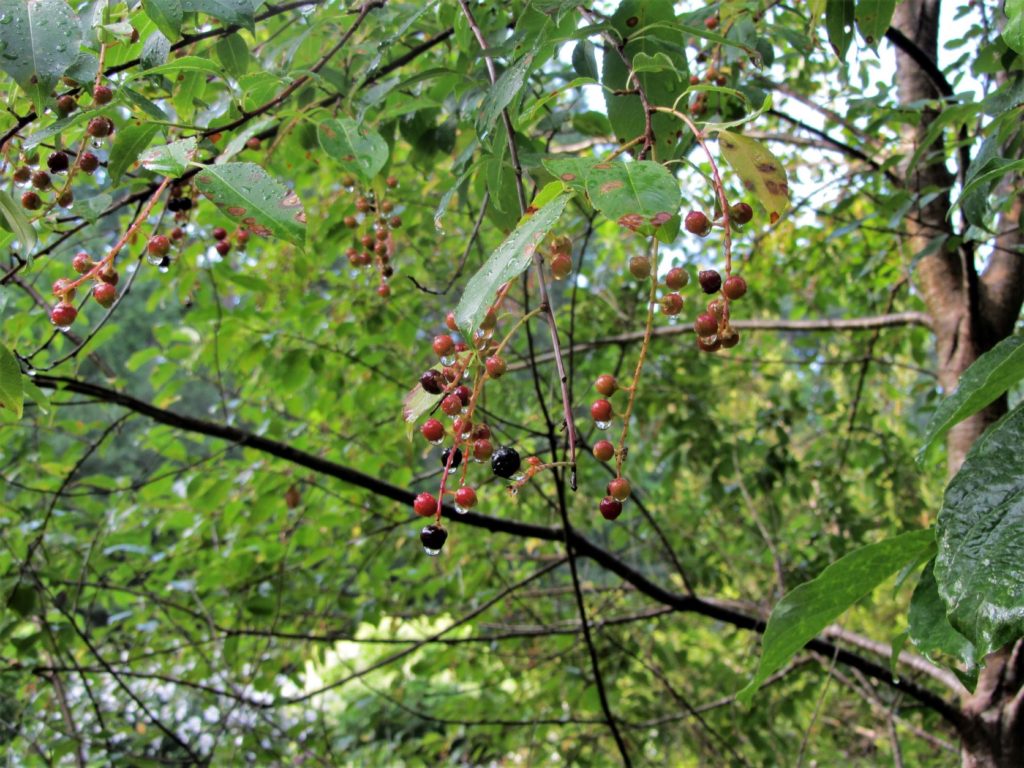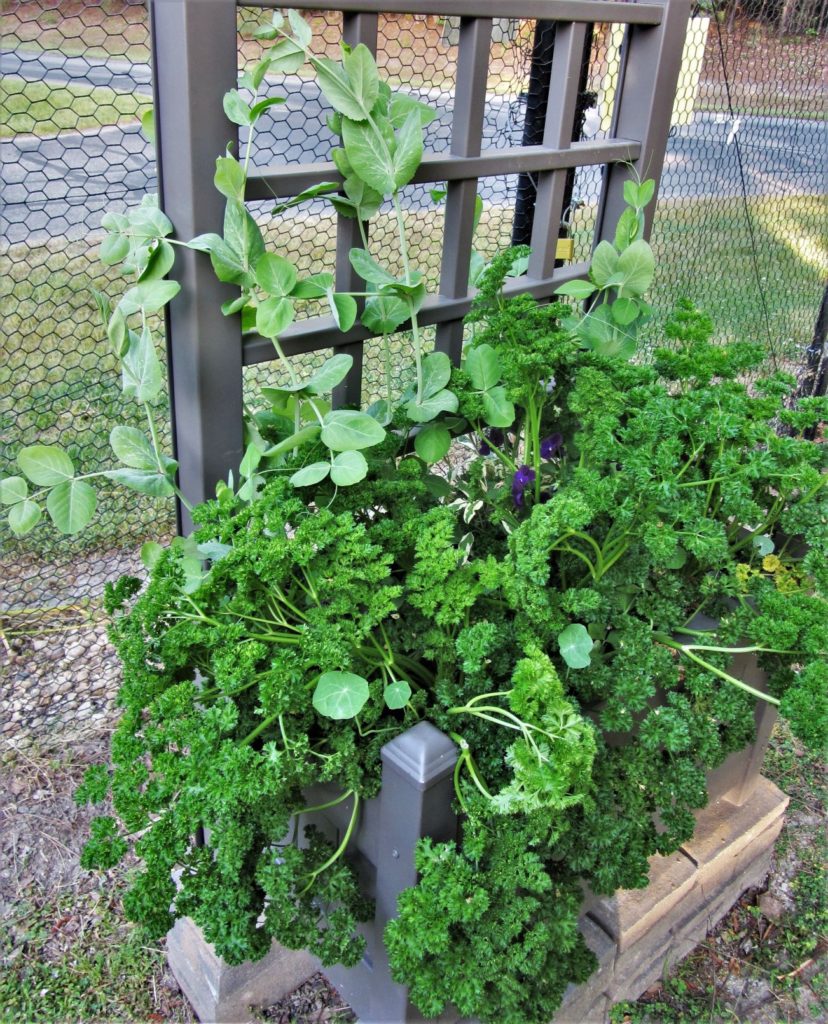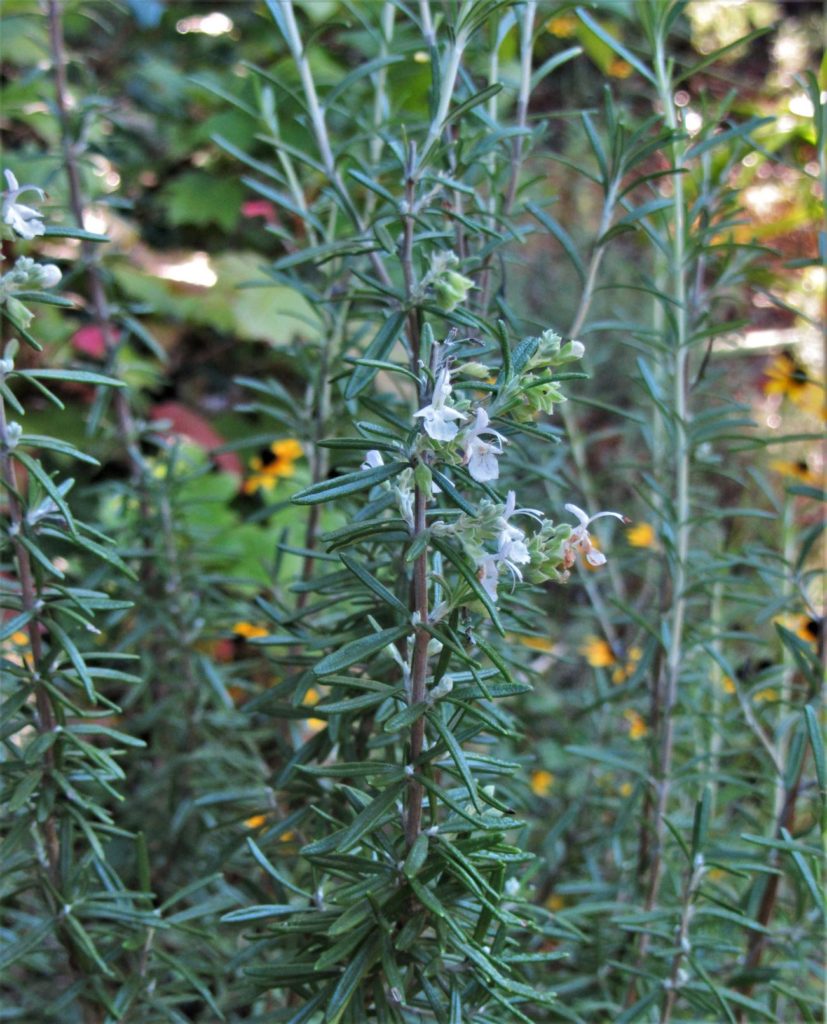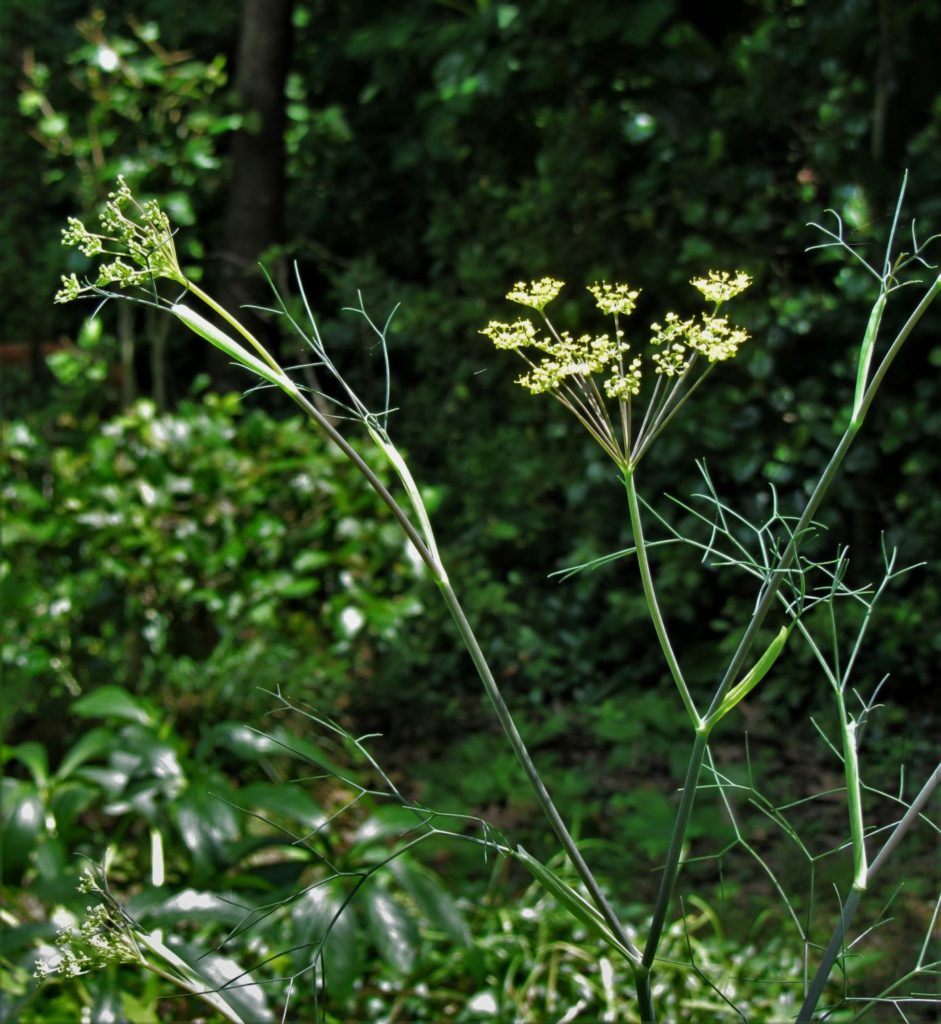Planting a ‘Food Forest’ at Home for Sustainable Harvests
Eastern North America flourished as an expansive ‘food forest’ for at least 40 million years. In what is now the Eastern United States, from New England to Tennessee and Alabama, the American chestnut tree, Castanea dentata, fed indigenous nations, colonists, American families and a wide range of wild and domesticated animals until the early 20th Century, when the chestnut blight decimated our forests. Chestnut trees grow to around 100’ tall and the oldest trees grew trunks 10’ in diameter. Each could produce hundreds of pounds of sweet chestnuts each autumn. Frontier cabins were built from their tough, rot resistant wood. Families ate the nuts whole, ground into flour, and sliced into a variety of dishes.
It took only 40 years for most of the prized chestnut trees in their native range to succumb to the blight, accidentally introduced from East Asia. Today, you’ll still find suckers growing from some of the old stumps in an attempt to re-establish a tree over still living roots. Some American chestnut trees in isolated populations still thrive.
In our area, a smaller relation, Castanea pumila, the Allegheny chinquapin, still grows and produces annual crops of delicious, high protein nuts. Somewhat vulnerable to the chestnut blight, this tree can be successfully planted in gardens and still grows in the wild. A member of the Fagaceae or Beech family, it is one of several hardwood trees that produce edible nuts. Other trees that provided food to our ancestors include pecan, walnut, hazelnut, hickory, oak, beech, crabapple, persimmon, paw paw, mulberry and redbud.
For most of human history, families relied on gathering foods growing in their environment for some portion of their diet. And many of these delicious and nutritious foods grow on long-lived trees or shrubs, from persistent perennials, or from plants that readily self-seed. This very sustainable form of agriculture allows for food production with few inputs of water, fertilizer or labor, once the plants establish. Perhaps most importantly, there is minimal disturbance to the soil’s ecosystem.
Perennial food forests actively sequester large amounts of carbon, and other greenhouse gases, during much of the year. The carbon is transformed into root mass, wood, leaves and fruits. Most of the gases absorbed are held in the soil or plant tissue in solid form. Some are released as water vapor or oxygen. Since the ground isn’t tilled or dug up, carbon isn’t released into the atmosphere from the soil, as it is in modern agriculture.
Permaculture means that long-lived plants bear crops over many years, without the need for annual re-planting. In our area, many farmers already raise blueberries, blackberries, peaches or apples. Strawberries may live a few seasons before replanting. Contrast this with the expensive and labor-intensive culture of peanuts, soybeans, corn, or even summer staples like tomatoes, melons, cucumbers and squash.
Home gardeners can realize many benefits from designing their landscape as a ‘food forest.’ Working in layers, as is common in good landscape designs, it is possible to plant large and small trees that produce annual edible crops. There are many good choices of food-producing shrubs, too. Perennial vegetables and herbs replace or enhance purely ornamental plants in pots, beds and borders. Raised ‘no-till’ beds, kept mulched throughout the year, can still produce many annuals vegetables and herbs grown from seed or transplants.
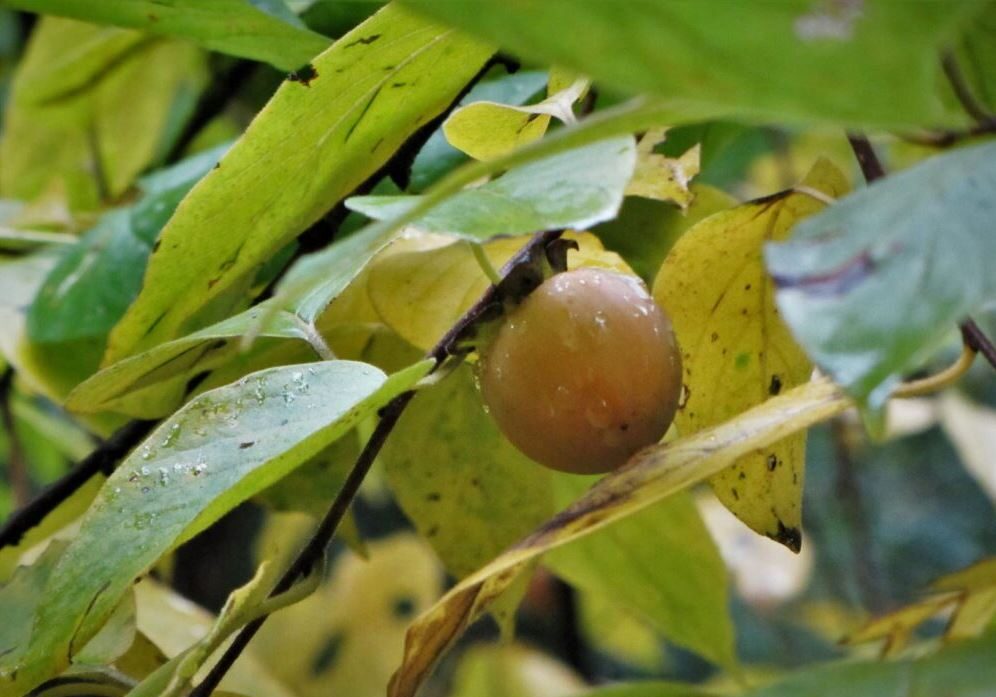
American persimmon, native in our area, may be grown from gathered seeds.
There are five main challenges to establishing a food forest landscape. In the beginning, there is considerable expense to plant the trees and shrubs. While savvy shopping and barter can help with this, it may require a substantial investment to begin. One way to approach this challenge is to take the ‘long view’ and plant a portion of the master plan each year over several years, allowing some trees to begin maturing while others are added. Knowing how many years a tree may take to produce helps in prioritizing purchases.
Which leads us to the second challenge: the time it takes for a tree to produce. For some, it may be a dozen years from sapling to fruiting. Others will be ready to crop in just a year or two. Most fruit and nut trees will need two or three of the same, or similar species, for cross-pollination. Others, like persimmons, are dioecious. In other words, trees are either male or female, and both are required for fruit production.
A third challenge stems from success. How will all of the harvest be managed and preserved? Are the homeowners able to physically maintain the trees and pick or pick up the ripe fruit and nuts to minimize waste? Most fruit and nut trees require pruning, especially in the early years. They may also need treatments in late winter or spring to manage pests. It is smart to learn about required care and expected yields for a particular species of fruit tree before planting.
The fourth challenge develops along with the food forest: shade. Many crops will grow in partial sun, or even light shade. Others require full sun. As the garden is planned and planted, it is smart to leave a few areas in full sun for the raised bed production of vegetables, or for fruit-bearing shrubs that require sun. It is also wise to plan the garden on graph paper before beginning to plant so that the many logistical challenges may be worked out in advance.
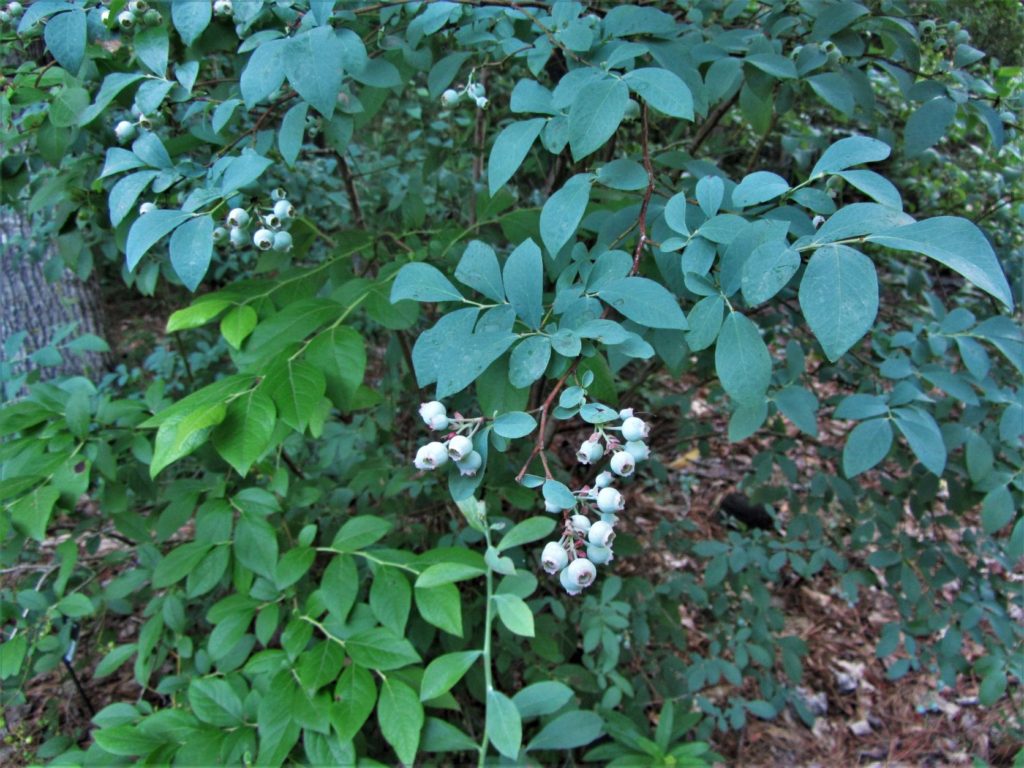
Native blueberries and huckleberries grow wild in our local woods. Many named cultivars may be purchased locally or from online nurseries.
The final challenge is posed by wildlife who want to share in the garden’s bounty. Deer, rabbits, squirrels, songbirds, raccoons and many other animals are attracted by an abundance of food and available water. Gardeners want to attract beneficial insects, like native bees that pollinate crops. Wise gardeners plant attractive flowering plants specifically to attract and support pollinators, knowing that they will also pollinate the food-bearing crop plants.
Deer, on the other hand, can decimate newly planted trees and shrubs in a single night of grazing. Squirrels will harvest unripe fruit and nuts. Rabbits may nibble on herbaceous vegetable crops. Voles and moles may eat plants from the roots up. In an area with abundant wildlife, fences and other barriers need to be included in the planning and investment. Use of chemical animal repellents (most are organic) and inter-planting unappealing Alliums, such as onions, garlic and chives, and planting strongly scented herbs, also helps repel grazers.
A perimeter fence will help keep large mammals, like a neighbor’s pets and deer, out of the garden. Newly planted shrubs and trees will benefit from barriers the first few years, and berry crops may need netting to protect ripening berries from hungry birds. As the garden matures, the need to protect individual trees from deer will be lessened.
It may be that a neighborhood, or even a cluster of families decide to pool their resources to plant and maintain a community food forest. There is such an abundant harvest from mature fruit and nut trees, that this is an attractive alternative to a single family taking on all of the investment and work involved. The harvest can be divided into shares for the participating families, and there might still be enough left to sell. When fruit and nut trees need nearby pollinator trees of the same species, those pollinators can be planted in neighboring yards. A cluster of homes supporting pollinating insects and abstaining from the use of insecticides and herbicides will support a greater insect community than a single property can support.
You may be surprised at the wide variety of plants that can be easily grown on a residential property in our area. Some are native plants, some are introduced or hybridized. You can often select a hybrid fruit that will grow to the size you prefer, and you can choose varieties that mature early in the season, mid-season or late-season, to lengthen the time of harvest. It pays to invest some time in research before purchasing trees, to find varieties best suited to your own needs and growing conditions.
Trees that produce edible nuts:
The pecan tree, Carya illinoinensis, is a good source of protein and the nuts are highly desirable. Yields are large, so it is possible to harvest nuts for one’s own use and also share, or sell, the surplus. This is a large tree, however, to 100′, and needs another tree nearby for pollination. This tree has a significant taproot and can be difficult to transplant. Bare root whips and saplings are readily available, and the tree may be started from seeds and cuttings.
The closely related edible hickory trees, Carya ovata and Carya laciniosa, are smaller, attractive trees with delicious nuts. These are slow growing, hardy, and will eventually grow to reach their full height of around 60′. Hickory trees volunteer in our area from nuts planted by squirrels and birds. Named cultivars, prized for the quality of their nuts, may be ordered from online nurseries.
A smaller edible nut tree, the Allegheny chinquapin, Castanea pumila, will only grow to around 30′. These can be pruned as multi-stemmed shrubs and provide delicious, high protein nuts each autumn. Closely related to the American chestnut, they can be susceptible to blight, but seem to be surviving in our area. This is a very attractive small tree. But it is also a delicious tree for grazing wildlife and will need protection to establish, if deer are a problem in the area.
American hazelnut or filbert trees, Corylus americana, grow quickly in dense, multi-stemmed thickets. Attractive throughout the year, they produce a heavy crop of small, edible nuts. Like other nut trees, the produce considerable shade and some shelter. Once established, stems from new growth may be cut for other purposes in the garden without harming the tree. Corylus will grow to 15’-18’ tall and wide, and it will usually bear nuts within 3 years of planting.
Other trees with edible, but seldom used nuts include the American Beech, Fagus grandifolia, and some oak species. Acorns from the white oak, Quercus alba, were commonly used as food by native Americans.
Trees and shrubs that produce fruits:
Other trees to consider for a ‘food forest’ planting would be the beautiful paw paw, Asimina triloba; various native blueberries and huckleberries; native crab apples, Malus species; and American persimmons, Diospyros virginiana. If planting persimmons, several trees should be planted to ensure that one is a male, as persimmons are either male or female.
The red mulberry, Morus rubra, also produces abundant fruit for several weeks in summer and supports a variety of wildlife. It grows 40′-60′ and can grow in sun or shade. Since it has a well-deserved reputation as a messy tree, it should be planted well away from walkways and driveways. There is some consideration that parts of the tree can be somewhat toxic, especially before the fruit is fully ripe.
The American Black Elderberry, Sambucus canadensis, grows as a multi-stemmed shrub to 12’ in full to partial sun. Fruit production is better in full sun. Both flowers and fruits are edible, but both are commonly cooked first. Leaves, roots and stems are considered poisonous to humans if eaten. The shrub tolerates many soil types and is drought tolerant once established. Fruits are produced in mid to late summer.
Wild blackberries and dewberries grow on thorny canes in full sun to partial shade. They flower and form fruits in the second year, so a cane may be cut out, once its fruit has been picked, to make way for a new cane that will bear the following summer. This is a valuable source of fruit for families and for wildlife and a productive blackberry patch will provide fruit to enjoy fresh and to preserve. Named cultivars will provide larger fruit, often on thornless canes. Plants grow to different heights and with different habits, depending on the cultivar.
Cherry and plum trees bloom in early spring and produce edible fruit. They are very beneficial to wildlife. There are attractive native species and named hybrids. Size varies by variety. Find a wide variety of selections from online nurseries. The native black cherry, Prunus serotina, produces very small, edible fruit in mid-summer. It is sometimes available locally at native plant sales or may be found growing in the wild, planted by birds.
There are many attractive selections of edible fig trees, Ficus carica. Some remain small enough to grow in large pots. Choose a named cultivar that meets your particular needs. These are all imported had hybridized varieties, and most selections have been developed for the quality of their fruit or their growth habit. You may choose one hardy in our area (Zone 7) or bring a tender fig into a frost-free space for the winter. Some varieties may die back to the ground each winter and then grow back from the roots, and others are completely hardy in our area and will grow a bit larger and more productive each year. Fig trees root easily from cuttings taken in late summer.
Shad bush, or coastal serviceberry, Amelanchier obovalis, produces red or purple edible fruits in May or June on relatively small shrubs to around 5’. This native shrub is easy to grow in full sun to part shade on a variety of soils and supports a variety of pollinators and other wildlife. It blooms with showy white flowers in mid-spring.
Many homeowners want to plant apple, pear, or peach trees because these are fruits families tend to purchase and enjoy. These trees require a lot of ongoing care and most require regular spraying with various preparations to prevent common bacterial and fungal diseases. It is much easier to properly prune and spray dwarf trees, which are commonly available from online nurseries. These trees require dedication and attention to detail to grow well. Various insects, squirrels and birds will compete for the harvest. Choose a tree carefully, paying attention to its needs for chilling hours each winter to select one that will produce well in our climate.
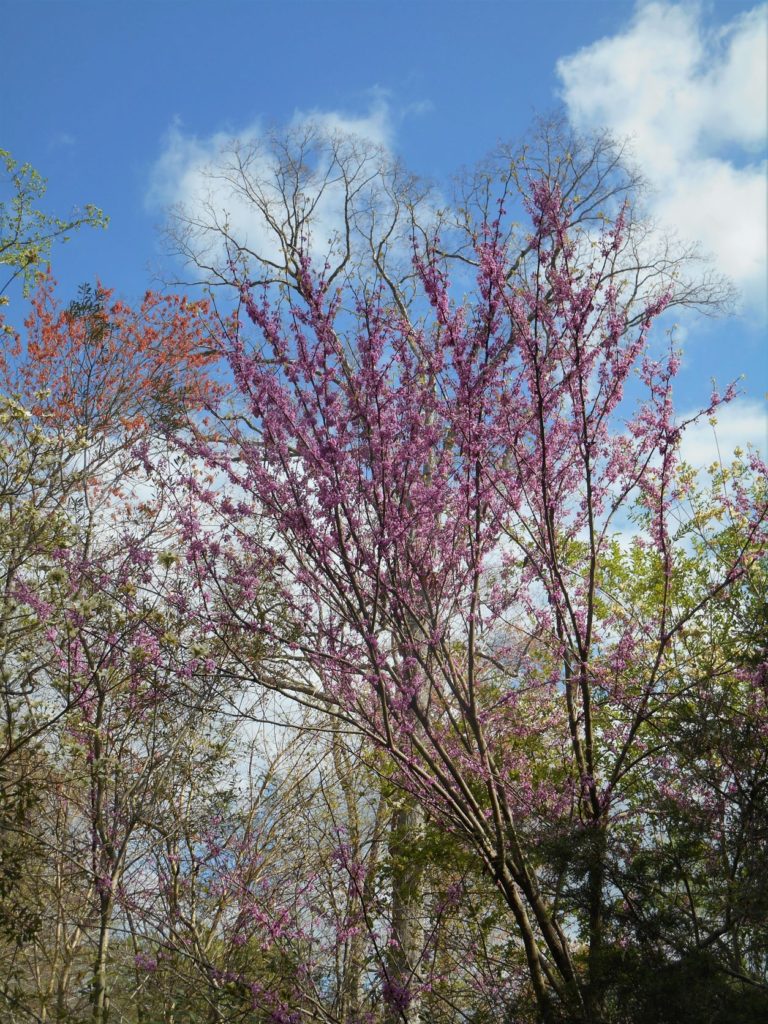
Eastern redbud trees, Cercis canadensis, fix nitrogen in the soil on their roots. Every part is edible from flowers to seedpods.
Trees to naturally fertilize the soil:
Eastern redbud, Cercis canadensis, is a small, beautiful tree with edible leaves, flowers, and ‘pea pods,’ that also supports wildlife. In addition to its early spring flowers and late winter support for pollinators, Cercis also fixes nitrogen in the soil, improving it for other crops. The tree is a legume, and it was a valued food source for indigenous people in our area. It is also an important host plant for many lepidoptera species. Cercis is highly adaptable, growing in sun or shade and on many types of soil. It grows quickly from seed or cuttings. Cercis is also available commercially and bare root whips are easy to grow and inexpensive from the Arbor Day Foundation, and various government sources.
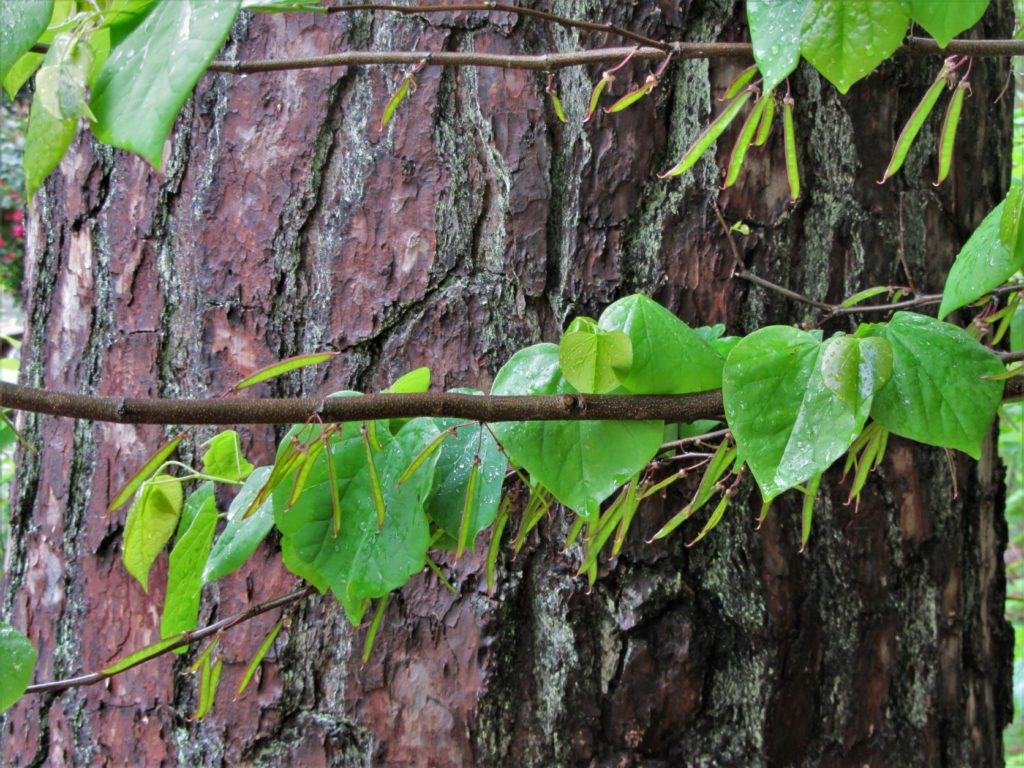
Seedpods on Cercis canadensis may be picked and eaten like pea pods. Cercis is a member of the pea family. Its leaves may be eaten, also.
Other trees that capture nitrogen from the air and ‘fix’ it in nodules on their roots include alders, Kentucky coffee tree, wax myrtle and black locust. There are several other non-native trees with this ability, some of which may be invasive and shouldn’t be introduced to a food forest.
Alfalfa, clover, beans, peas and peanuts also have the unique ability to improve the soil by transferring nitrogen from the air to their roots. The nitrogen enriches the soil and may be used by nearby plants to fuel their growth.
Herbs:
Perennial and annual herbs make a great addition to a food forest in full or partial sun. Most are very drought tolerant once established and need little ongoing care, beyond occasional pruning/harvesting. Blooming herbs attract beneficial insects which in turn will help pollinate trees and other crops. Once planted, perennial herbs provide many years of fresh herbs and beauty in the landscape. Most herbs belong to the Lamiaceae, or mint family.
Use leaves fresh or dried in cooking, as garnishes, or raw in salads or salsas. Most may be brewed in teas.
Perennial herbs:
Rosemary, Salvia rosmarinus (since 2017), or Rosmarinus officinalis (former name), ‘Arp’ and ‘Barbecue’ are good cultivars for our climate. Prostrate Rosemary is a great choice for pots and the edges of raised beds.)
Rosemary is a hardy, woody evergreen herb that blooms periodically throughout the year. It will often bloom in late autumn or very early spring when there is little else for pollinators. It has culinary and medicinal uses. It will grow to 4’+ tall and wide, depending on variety, and grows in full to partial sun. It prefers well drained soil and won’t survive in wet spots.
Sage, Salvia officinalis culinary sage is a woody, somewhat hardy evergreen shrub that has both culinary and medicinal uses. There are several varieties on the market, including several with variegated leaves. Most varieties of sage grow to 1’-2’ tall and wide and can be used in pots or in beds and borders. Grow in well-drained soil in full sun. Sage dislikes wet soil and is very drought tolerant once established.
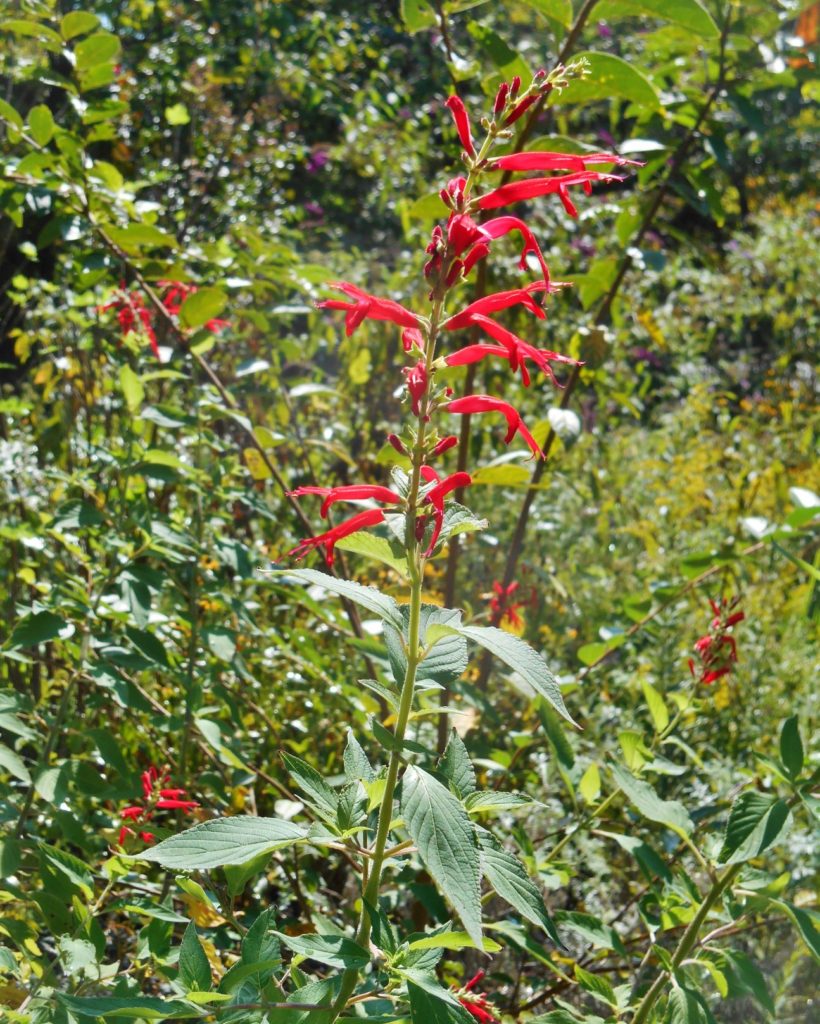
Pineapple sage, Salvia elegans, provides sweetly flavored, fragrant leaves. Late hummingbirds appreciate its flowers, which open in September and October. It is a favorite for butterflies, and the flowers are edible.
Thyme, Thymus vulgaris, is a low growing evergreen herb with culinary and medicinal uses. There are many different cultivars with slightly different flavors, including lemon thyme. Some varieties are variegated but all have a similar growth habit, with tiny leaves on woody stems. Thyme is a good edging or groundcover plant that is loved by pollinators when in bloom.
Mint, Menthus species, are perennial deciduous plants with culinary and medicinal uses. Menthus spicata, spearmint, is the most common culinary species. Menthus suaveolens, apple mint or pineapple mint, is also desirable. Most mints have a strong fragrance which repels biting insects, and blooms during the summer to support beneficial pollinators. Mint spreads by runners and may become invasive. Grow in full to partial sun in moist, fertile soil. Propagate by divisions or cuttings. There are many attractive cultivars and hybrids, including chocolate mint, ginger mint, peppermint, and even orange or apple mint.
Lemon balm, Melissa officinalis, has a strong citrus flavor and aroma. It may be used fresh or dried in teas or in cooking. Closely related to other herbaceous mints, it has a similar growth habit and spreads enthusiastically.
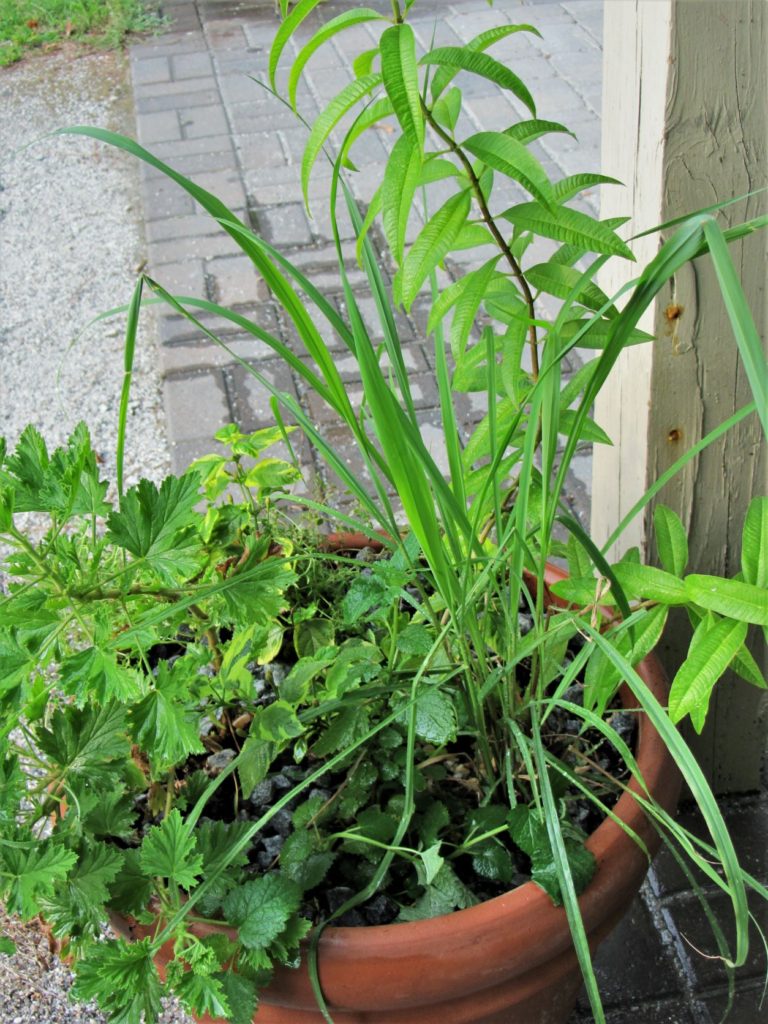
Lemongrass is actually a grass, native to India. It grows here with lemon Verbena, scented geranium, lemon balm and lemon thyme. The variegated Lantana isn’t edible.
Lemon Verbena, Aloysia citriodora, is a deciduous woody shrub with strong citrus aroma and flavor with medicinal and culinary uses. Native in South America, this member of the Verbena family is hardy in Zones 8-10. While it may survive a mild winter, it drops its leaves at first frost. The plant can be kept in a pot indoors in bright light through the winter or kept as rooted cuttings from one season to the next. It is prized for its edible leaves and its essential oils.
Fennel, Foeniculum vulgare, is a deciduous perennial herb with culinary and medicinal uses. Available as bronze fennel, green fennel or Florence fennel, all parts of the plant are edible including leaves, flowers, and seeds. Florence fennel forms a swollen base at the bottom of the stems, which may be sliced and eaten raw or cooked. Fennel leaves and seeds may be used fresh or dried. Fennel hosts many lepidoptera species and is also an important nectar source for pollinators. Grow in full or part sun in pots or planting beds. It may self-seed into nearby areas.
Chives, Allium schoenoprasum, and Garlic chives, Allium tuberosum, are deciduous perennial herbs with culinary and medicinal uses. Chives bloom with purple flowers in early summer and garlic chives bloom with open, white flowers in late summer and fall. Garlic chive leaves may remain green through the winter in Zone 8 and warmer. The attractive flowers attract beneficial pollinators. Leaves are used fresh or cooked for their mild onion/scallion/garlic flavor. Flowers and flower buds are edible and may be used as a garnish and in salads. Chives will seed themselves around and will grow on a variety of soils in full or partial sun to part shade. Propagate by seed or by division.
Annual or Biennial Herbs
Annual herbs such as basil, dill and cilantro/coriander grow, bloom, set seed and die back during the summer months. They survive from one year to the next as seeds or rooted cuttings. Their leaves have culinary uses fresh, dried, or cooked.
Basil flowers are edible and may be used for garnish. Cilantro and dill leaves have many uses in salads and salsas. Dried cilantro seeds, known as coriander, and dried dill seeds, are essential to many cuisines.
German chamomile, Matricaria recutita, is an annual plant while Roman chamomile, Chamaemelum nobile, is a perennial. Both are grown for their flowers in full sun and may be used in making teas.
Biennial herbs, like parsley, form a taproot during the first season’s growth and bloom in the second season. Their leaves and stems may be eaten fresh, dried, or cooked. Parsley is an important host plant for lepidoptera. Many different pollinators and beneficial insects are attracted to the flowers of all three of these herbs. Grow them in fertile, moist soil in full to partial sun.
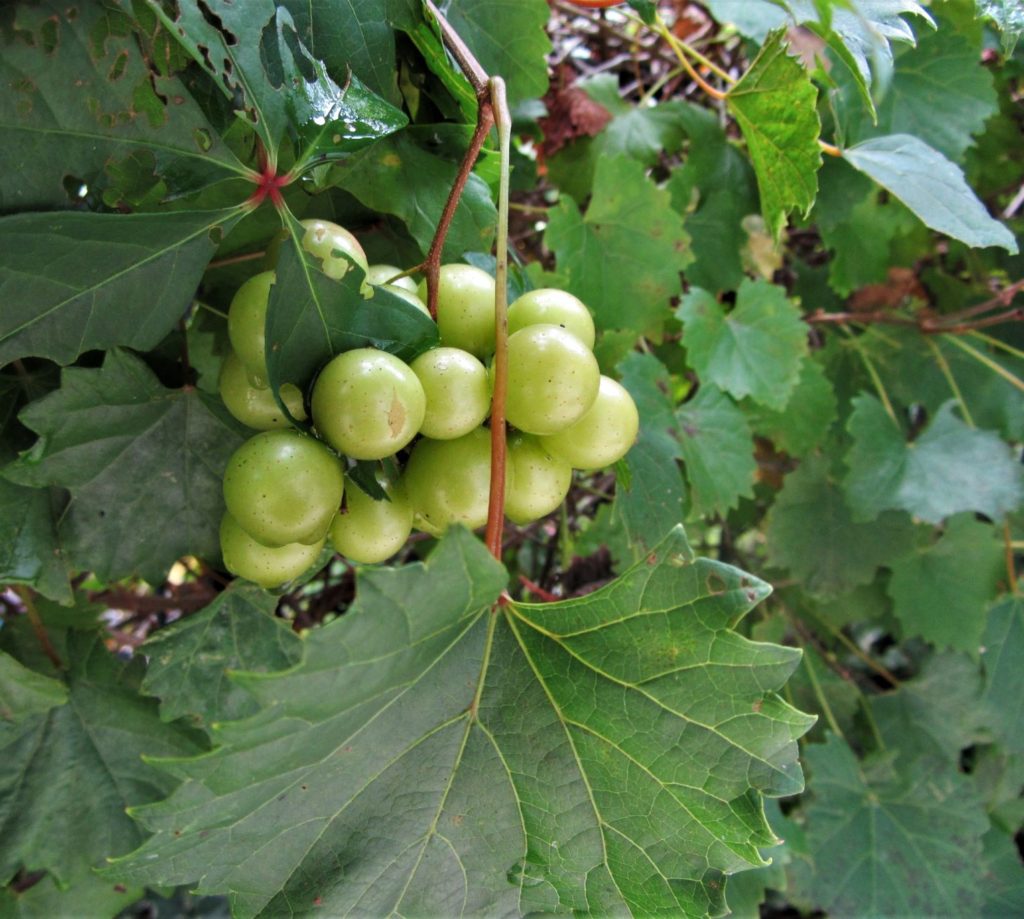
Native muscadine grapes ripen in late summer. Their leaves are edible raw or cooked and may be picked from early spring through fall.
Perennial vegetables
Perennial vegetables require a dedicated garden space, in full to partial sun, where they can grow undisturbed over several years. They respond well to sustainable, no-till gardening methods and need limited irrigation or fertilizer once established, partly because they are grown in well-mulched beds rich in compost.
Asparagus, Asparagus officinalis, is the most commonly known perennial vegetable. Asparagus roots or divisions usually require two to three years of growth before the first good harvest. Asparagus shoots are harvested in spring, and then shoots are allowed to grow into full sized leaves through the rest of the season. They can grow 5’-6’ tall and must be cut and cleared away before new growth begins in early spring.
Rhubarb, Rheum rhabarbarum, may also need a few years of growth before you have a good harvest. The stalks (stems) are cooked for stews or pies. Leaves are poisonous and should be discarded. Any flower stalks must be removed as soon as they appear. Plant rhubarb crowns/roots in fall or early spring, giving plants 4’-6’ of space between crowns in full to partial sun. Some varieties can grow quite large and are ornamental.
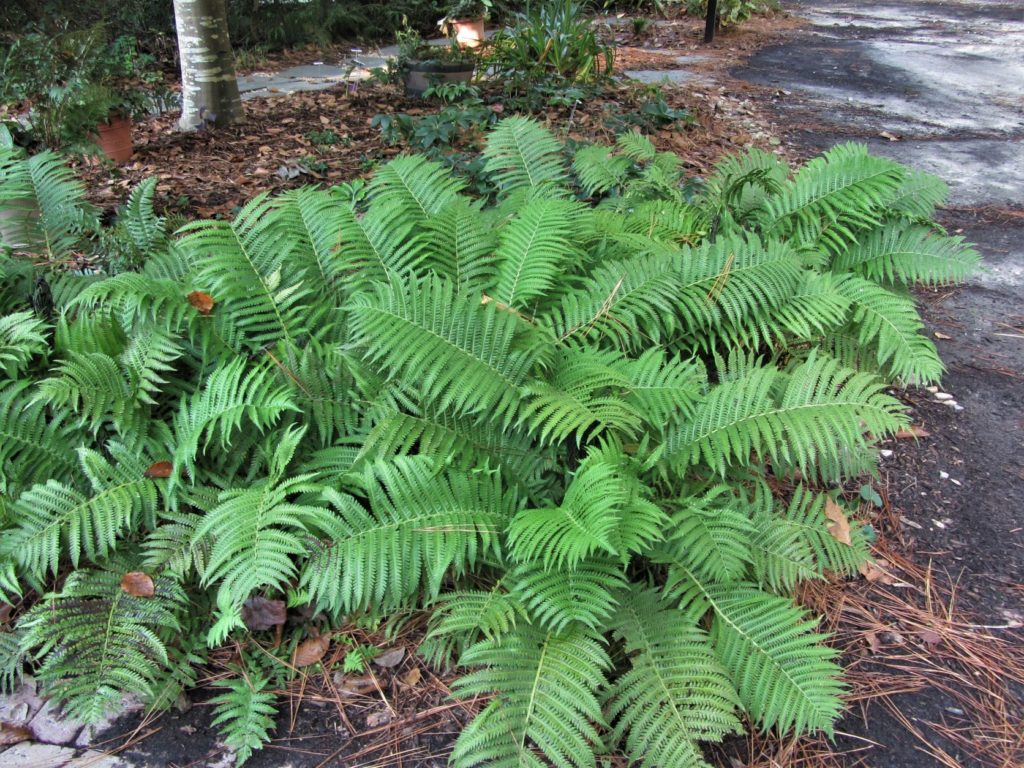
Harvest young fiddleheads from the ostrich fern, Matteuccia struthiopteris, as they emerge each spring.
Several other perennial vegetables, like Jerusalem artichokes, Helianthus tuberosus, are grown for their tubers. This member of the sunflower family is very ornamental when in flower and may spread aggressively once planted. Jerusalem artichokes may be purchased in many grocery stores and the tubers planted in prepared beds in full sun.
Ginger and turmeric grow as tender rhizomes. Both produce attractive leaves and flowers. You can start with pieces found in the produce section of the grocery store and grow them in pots or beds until frost. Overwinter in a frost free space or start new plants each year.
Native arrowheads, Sagittaria species, grow wild in local waterways. They may be planted in low areas that remain wet and have occasional standing water, and in rain gardens. Native Americans used their tubers for food. The spring blooming Camassia flower, blue camas, which also prefers wet soils, were also harvested by native Americans while blooming so the bulbs could be roasted or boiled.
Other perennial vegetables may be native or naturalized plants often overlooked as weeds. Dandelions and dock, Rumex species, come to mind. But fiddleheads from ostrich ferns, Matteuccia struthiopteris, are harvested in spring and steamed or battered and fried for a special spring treat. These grow well in moist shade and spread by their rhizomes to create an increasing patch year to year.
Some types of chickory, Belgian endive or radicchio, have perennial roots. Every part of a daylily plant is edible, from its flowers to its tubers. Horseradish, Yucca and ground nut are additional perennial vegetables grow for their roots or tubers.
Some varieties of Colocasia esculenta, or taro, are grow as food in the Pacific islands. Colocasia tubers and leaves have culinary uses. Parts of these plants are also poisonous, especially raw, and so a bit of research is needed to use the plants properly.
Bamboo, while not native in our area, has naturalized in many places. Technically a grass, its tender shoots are entirely edible. Bamboo is highly invasive and aggressively sends its roots and rhizomes searching for new real estate. If you already have a stand nearby, you can control it (a bit) by harvesting its new shoots in early summer to eat fresh, cook, freeze or can. Otherwise, it is wise to grow bamboo in a large barrel or trough to keep it from taking root in your yard. It will grow in a variety of soils from sun to partial shade.
Creating a productive ‘Food Forest’ around one’s home becomes more life-style than hobby. Every season of the year has its own tasks as well as its own harvest. Of course, planting just a few well-chosen food-producing trees, shrubs and herbs can still supplement a family’s menu without requiring a huge investment of time or resources. Autumn is the best season for planting trees and shrubs, as temperatures cool and new plants have the opportunity to establish good roots before another growth spurt in spring. The next few months offer us the perfect opportunity to begin our own Food Forest.
It is wise to begin with a little planning and research.
Resources for further exploration:
Austin, Rick. Secret Garden of Survival: How to Grow a Camouflaged Food- Forest. Createspace Independent Publishing Platform. 2012.
Crawford, Martin. How to Grow Perennial Vegetables: Low-Maintenance, Low- Impact, Vegetable Gardening. UIT Cambridge.2012.
Frey, Darrell. The Food Forest Handbook: Design and Manage a Home-Scale Perennial Polyculture Garden. New Society Publishers. 2017.
Hemenway, Toby. Gaia’s Garden: A Guide to Home-Scaled Permaculture. Chelsea Green Publishing. 2009. (2nd Edition)
“Diospyrus virginiana, The Divine Fruit” JCCWMG.org November 2022
“Foraging for Autumn Harvests” JCCWMG.org October 2022
All Photos by E. L. McCoy


